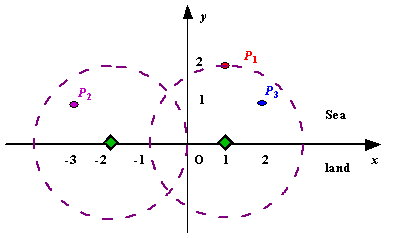传送门:poj1328 Radar Installation
题目大意
在一条水平的海岸线上,上面是海洋下面是大陆,还想里面有n个孤岛,在海岸线上可以放雷达,雷达的最大距离为d,题目原图:

可以抽象为一个直角坐标系,p1(1,2),p2(-3,1),p3(2,1)分别为三个孤岛,在海岸线上最多放两个雷达就可以检测到所有的孤岛,
输入:第一行输入孤岛数量n,以及雷达检测的最远距离d,
下面的n行分别为孤岛在坐标系中的坐标,当输入(0,0)的时候结束程序。
输出: 对于每一组数据,输出需要多少个雷达,如果有不能检测到的输出-1;
按照下面得格式输出:Case X: Y,就算是输出-1的话也要输出前面的case
解题思路
我们可以以每个孤岛在直角坐标系中的坐标为圆心,雷达的最大检测距离为半径做一个圆,找出这个圆和海岸线(y=0)的交点区间,如下图:

孤岛与海岸线的交点分别为(x1,0),(x2,0),也就是说海岸线在[x1,x2]之间都能检测到该孤岛。其他的孤岛一样的道理。然后我们按照这个区间的左区间进行排序。
然后分为下面的情况进行判断:
我们设排序完的区间的第一个的右区间为最长区间
1. 当第i个的做区间大于最长区间的时候,雷达数+1;
2. 当第i个区间的左区间小于最长右区间,并且第i个区间的右区间大于最长区间,最长区间不变
3. 当第i个区间的左区间小于最长右区间,并且第i个区间的右区间小于最长区间,最长区间变为第i个区间的右区间。
AC代码
#include<cstdio>
#include<cstring>
#include<set>
#include<stack>
#include<cmath>
#include<cstring>
#include<string>
#include<algorithm>
#include<queue>
#include<cstdlib>
#include<iostream>
using namespace std;
typedef long long LL; //lld
struct Node{
double left;
double right;
}radar[100000];
double min(double a,double b)
{
if(a>=b)
return b;
else
return a;
}
double max(double a,double b)
{
if(a>=b)
return a;
else
return b;
}
bool cmp(const Node a,const Node b)
{
return a.left < b.left;
}
int main()
{
int n,d;
int islandLeft,islandRight;
int i,j;
int count1=0;
while(true)
{
count1++;
bool flag = false; //当超过雷达的检测范围的时候,改变状态
int sum=1;
scanf("%d%d",&n,&d);
if(n==0&&d==0)
break;
for(i=0;i<n;i++)
{
scanf("%d%d",&islandLeft,&islandRight);
if(islandRight > d)
flag = true;
radar[i].left = islandLeft * 1.0 - sqrt(d * d - islandRight * islandRight); 按照圆的方程求出左区间和下面的额右区间
radar[i].right= islandLeft * 1.0 + sqrt(d * d - islandRight * islandRight);
}
if(flag)
printf("Case %d: -1\n",count1);
else
{
sort(radar,radar+n,cmp);
double maxRight = radar[0].right;
for(i=1;i<n;i++)
{
if( (radar[i].left - maxRight) >0.0000001)//浮点数不能直接比较
{
maxRight = radar[i].right;
sum++;
}
else if( (radar[i].right - maxRight) <0.0000001)
{
maxRight = radar[i].right;
}
}
printf("Case %d: %d\n",count1,sum);
}
}
return 0;
}























 260
260

 被折叠的 条评论
为什么被折叠?
被折叠的 条评论
为什么被折叠?








